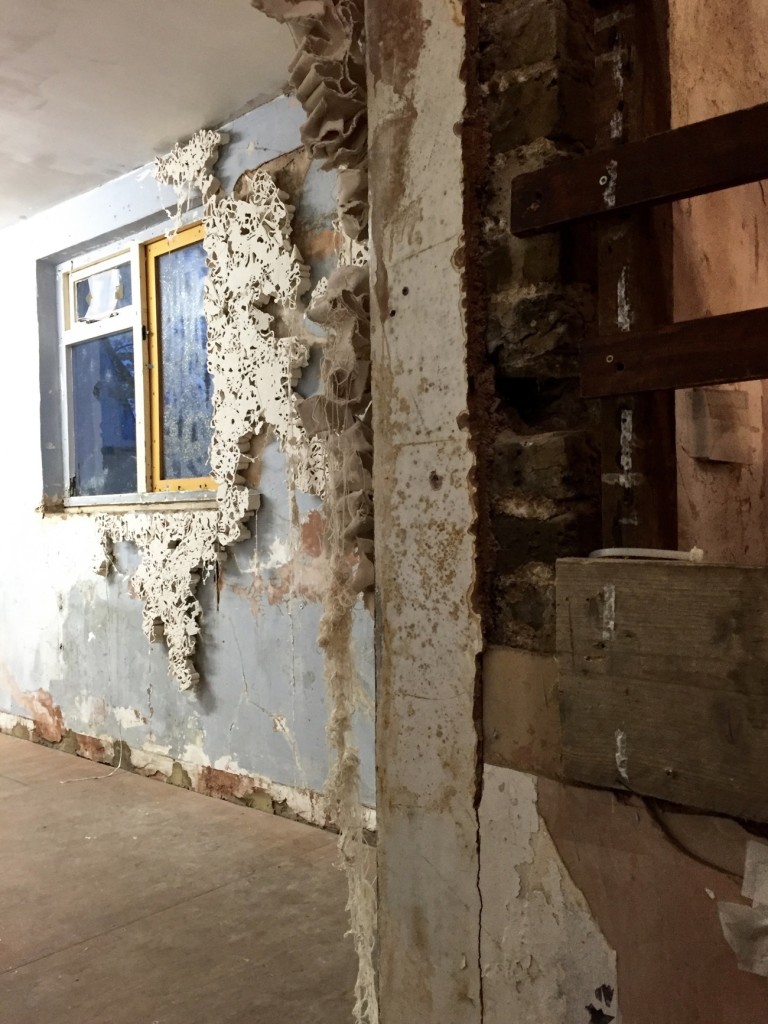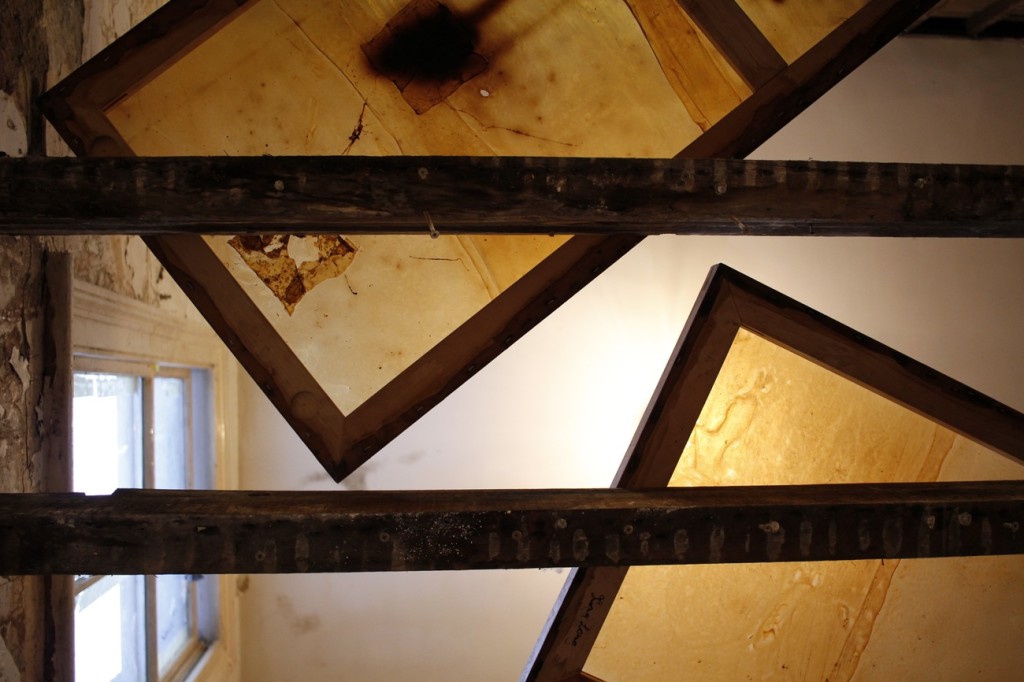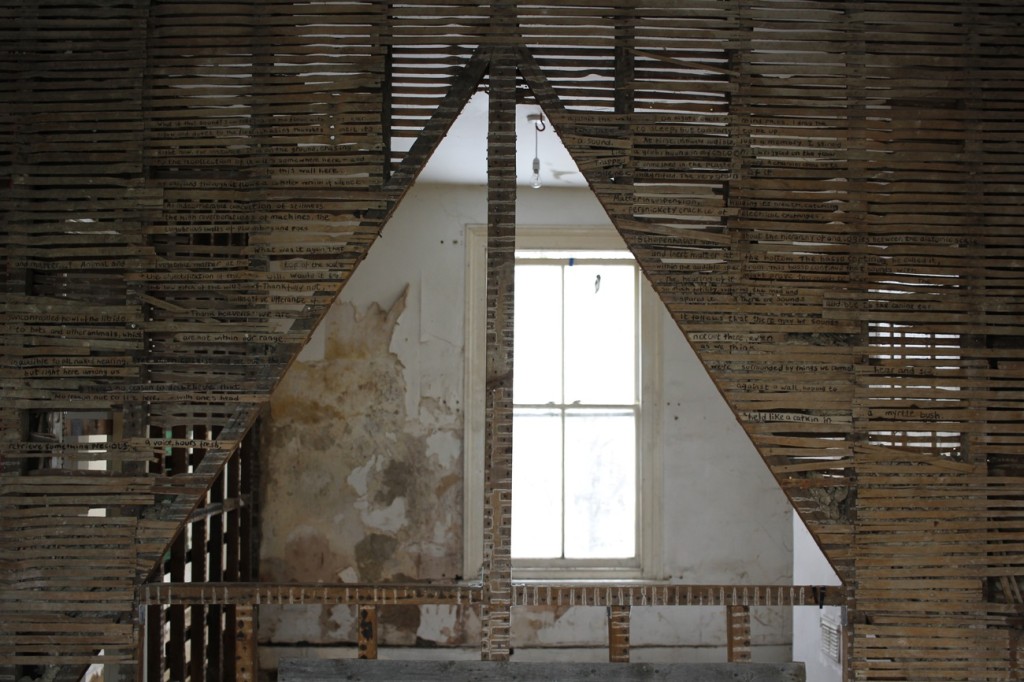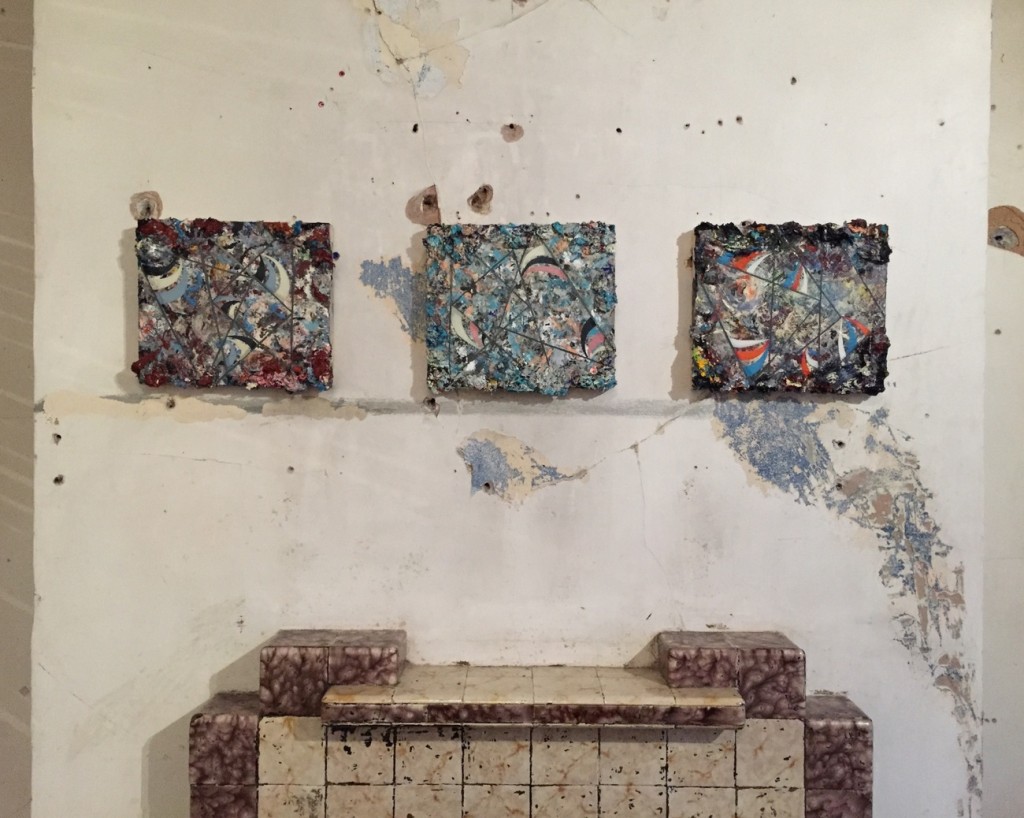In November 2015, eleven artists took on a Victorian ruin. I was one of them. The resulting exhibition, HOUSEWORK, set out to re-inhabit the stripped-out terrace. In it, paintbrushes and brooms became interchangeable as artworks spilled out into architecture or architecture seeped into art. Words were regarded and discarded; sound waves scribbled in haste; phrases begun and never finished; and the abandoned guts of a building reassembled.
Installed in Safehouse1 in south London and curated by Simon Haddock, the exhibition spanned painting, drawing, sculpture, sound, text and installation. Many of the works were made with the skeleton terraced house in mind and all were selected for their capacity to talk to the open studwork and peeling walls of the house. Brought together, they considered the day-to-day practice of creative activities, the necessary daily grind. They questioned the points of contact between one’s working days in the studio or study and one’s domestic life. To what extent do the spaces of domesticity and practice – physical or actual – bleed into one another?
HOUSEWORK ran for just five days, though how long it lingers in memory is harder to gauge. This account is presented as part gallery tour part house viewing. But its temporal remove, drawn up over the months following the show, leaves my impressions at the mercy of the vagaries of passing time. I sometimes find myself distracted by enduring details, at others, dwelling on the vistas and connections that the skeletal space made possible.

Ground Floor: Front Room
Occupying the first room on the ground floor were Dorian MacFarland’s Galapagos and Maladroit. A Tupperware box hung like a light fitting, its contents emitting self-generating audio from a small speaker. It chirruped away, as if singing to flyers pasted across the front room wall – left-handed drawings of sound waves similar to those being transmitted aurally.
Close by, a pair of Paul Carter’s works – one hung, one propped – jutted awkwardly into the room, at an angle and off-centre. Their positioning was deliberately uneasy. This duo were like bus hoardings filled with city detritus: rubbish, splintered wood, sodium yellow tape and poured concrete. They were disturbingly airless; a flower press of a city’s remains, compressed, sliced and framed. Strewn, close by, and piled obsessively was my own contribution, Drift. This mound of eight prose-poems on paper were screwed up and thrown into a corner to be pocketed or tossed as visitors saw fit. The texts gave form to the internal voice of self-doubt – that at once gives rise to and subverts creative practice.

Ground Floor: Lean-to
Around the corner, Jo Dennis had wrapped part of a wall tightly with a large piece of brightly coloured splattered and smeared canvas. Once installed, Dennis worked on Absence of Reason in situ, allowing it to merge with the surrounding walls, even introducing the shadow of a skirting board.
Opposite, Jessie Makinson painted her mural entirely on site the day before the show opened. Her anthropomorphized, basketball-playing, clouds, with multiple robotic arms, stretched irreverently and semi-erotically across a pockmarked white wall.

First Floor: Bathroom
Upstairs, Lesley Blakelock’s Rend saw outgrowths of ripped strips of canvas resembling intestines hugging the walls. Cast in jesmonite and uncoloured, they framed a nearby window and entrance, their frayed tendrils hanging around like spider’s webs. In the same room was Playpaint. Despite his work’s slick finishing even here reflections of the house emerged – most notably in his Contemporary Build Noir Device. Tucked into a corner was a small, mainly black canvas of spray paint, acrylic and varnish. Its motif of yellow striped circles reiterated the circles of exposed plaster nearby, where layers of household paint had been ripped off with the removal of bathroom tiles.

First Floor: Bedroom I
In the heart of the house was Fiona Long’s Mother, Daughter, Imp – a series of framed canvases that lay upon the bear beams of the first floor and could be viewed from above and below. A ceiling skin. Long grows her canvases from colonies of bacteria and yeasts and their sheer skins glowed golden when light hit them from above.

First Floor: Bedroom II
In the final upstairs room, Isabel de Vasconcellos scribed extracts from her forthcoming book in charcoal directly onto the exposed wooden horizontal slats of wall. Her words evoked sleepless nights, disintegrating fully formed sentences into unfinished phrases that trailed off across spaces in the lath.
In the same room was Simon Haddock’s Apertures, two sheets of ply of a dimension you’d find in a builder’s merchants, screwed directly to the wall. The painting took the wall and the nature of its placement in the bedroom as its starting point. Its painted, scored, pitted and routed surface appeared as if grown from the holes, scratches and other physical vestiges of the wall that it obscured.
Opposite and in contrast to the forms growing out of the wall, Phillip Allen’s diminutive though heavily paint-laden boards, akin to painters’ palettes, hung above a smokey Art Deco fireplace. Hung like this, in recognition of the quiet conventions of a domestic space, their impasto texturing revealed intimate worlds that appeared to spill out across the exposed layers of paint on the wall behind.

But, despite all this, key for me, as a participating artist, was what happened before HOUSEWORK opened. For two days running up to the show, the abandoned terrace was, as you might expect, abuzz with activity. As the eleven artists prepared their works – many of which were made on site (either partially or completely), hanging them, wrapping them, throwing them, propping them up, laying them to rest – our collective and individual labour gave rise to conversations that otherwise would never have emerged. And HOUSEWORK, strongly reflected those conversations, making use of the variety of vistas, angles and visual relationships granted by the architecture of Safehouse1. This Victorian terrace fostered a series of conversations between makers and made alike, between the process of making and the intuitive adjustments that go on behind the scenes and under the surface of art and practice.
There are more plans already afoot for HOUSEWORK. But, for now, let this act as a kind of incomplete archive of the exhibition.
HOUSEWORK took place at Safehouse1, London from 25th to 29th November 2015.
Image credits (from top):
1. Lizzie Lloyd, Drift, text on paper, dimensions variable, 2015
2. Paul Carter, Don’t Worry About Architects (Wall), 108cm x 5cm x 145cm, 2015 & Dorian McFarland, Maladroit, graphite on paper, 2015
3. Lizzie Lloyd, Drift, text on paper, dimensions variable, 2015
4. Jo Dennis, Absence of reason, acrylic and household paint on canvas, dimensions variable, 2015
5. Jessie Makinson, Wall Drawing (detail), acrylic, 2015
6. Lesley Blakelock, Rend (installation), jesmonite and canvas, dimensions variable, 2015
7. Fiona Long, Mother, daughter, imp, symbiotic colony of bacteria and yeasts, 60cm x 150cm (dimensions variable), 2015
8. Simon Haddock, Apertures, acrylic, charcoal and marbledust on ply, 244cm x 244cm, 2015
9. Isabel de Vasconcellos, Filter, charcoal on lath, dimensions variable, 2015
10. Phillip Allen, (l-r) picking the low hanging fruit – Bourgeois Piety Version, picking the low hanging fruit – Curry Night Version, picking the low hanging fruit – Austin Midnight version, all oil on board, 30cm x 26 cm, 2015
Photo credits:
1, 3 & 8 © Owen Lloyd
2, 4, 5, 6, 7, 9 & 10 © Dorian McFarland









